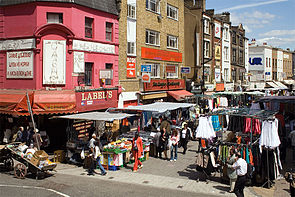Petticoat Lane

The market in 2006
|
|
| Location |
Spitalfields London, E1 United Kingdom |
|---|---|
| Coordinates | 51°31′0″N 0°4′24″W / 51.51667°N 0.07333°WCoordinates: 51°31′0″N 0°4′24″W / 51.51667°N 0.07333°W |
| Management | Tower Hamlets London Borough Council |
| Owner | Tower Hamlets London Borough Council |
| Environment | Outdoor |
| Goods sold | Clothing, general goods |
| Days normally open | Sunday (Middlesex Street) Sunday–Friday (Wentworth Street) |
| Number of tenants | 202 (Middlesex Street) 138 (Wentworth Street) |
Petticoat Lane Market is a fashion and clothing market in the East End of London. It consists of two adjacent street markets. Wentworth Street Market is open six days a week and Middlesex Street Market is open on Sunday only.
It is one of a number of traditional markets located to the east of the City of London. A few hundred yards to the north is Old Spitalfields market, which has been refurbished, and across Commercial Street, to the east, lies Brick Lane Market. A half mile further east is the Columbia Road Flower Market. Petticoat Lane Market was not formally recognised until an Act of Parliament in 1936, but its long history as an informal market makes it possibly one of the oldest surviving markets in Britain.
The market is open Monday to Friday on Wentworth Street; on Sunday it extends over many of the surrounding streets, with over a thousand stalls. It is closed on Saturday, and on Sunday closes at about 2 pm. The markets are well signed from local stations. Petticoat Lane market is listed as a tourist attraction on VisitLondon.com, the official visitor guide for London. The name Petticoat Lane came from not only the sale of petticoats but from the fable that "they would steal your petticoat at one end of the market and sell it back to you at the other."
In Tudor times, Middlesex Street was known as Hogs Lane, a pleasant lane lined by hedgerows and elms. It is thought city bakers were allowed to keep pigs in the lane, outside the city wall; or possibly that it was an ancient droving trail. The lane's rural nature changed, and by 1590, country cottages stood by the city walls. By 1608, it had become a commercial district where second-hand clothes and bric-à-brac were sold and exchanged, known as 'Peticote Lane'. This was also where the Spanish ambassador had his house, and the area attracted many Spaniards from the reign of James I. Peticote Lane was severely affected by the Great Plague of 1665; the rich fled, and London lost a fifth of its population.
...
Wikipedia
